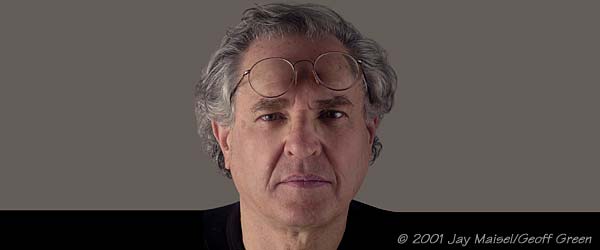Exclusive
photographs from Jay's NYC studio
Introduction
Jay Maisel is recognized as one of the top natural-light color
photographers in the world. Shooting commercially since the mid 1950's, he
has always been considered a purist, not doing any image manipulation and
only having dye transfer prints done of his images. He is now shooting
100% digital with Nikon's D1 digital camera, and printing his photographs
on an Epson 1270. Over the years, his images and style have inspired
countless photographers. It's fascinating to see how current technology
has changed his working methods and his definitions. Jay's latest book,
published by Firefly Books (ISBN: 1-55209-496-0), contains 160
color photographs and is titled, appropriately, "Jay Maisel's New York".
Chris/Larry: Let's begin by talking about
your new book, "Jay
Maisel's New York." You've been shooting pictures of New York for
what, 45 years now?
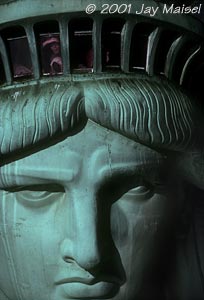
Jay: Yes.
Chris/Larry: Your new book has some truly wonderful images.
Jay: Thank you.
Chris/Larry: Over what time span were those images shot?
Jay: Well, there are some that go back almost 45 years, but
the great majority of them are, I'd say, in the 80's and the 90's.
Chris/Larry: Does it contain any images that were shot
digitally?
Jay: No.
Chris/Larry: Did you revisit any of them with Photoshop? In any
way update them?
Jay: No, let me put it this way. I have made prints from them, and
we use Photoshop, of course. But we're not attempting to do any
manipulation with them. As you know, it's a slippery slope. Because you
say, well, I don't want to change it, but I really don't have the
contrast here that I wanted. And so you start getting into a little
rationalization on it. But for the most part, what we're just trying to
do, our motivation is not to change it. Our motivation is to recreate
the image that was on film. So that you might do something in terms of
contrast to retain what you had. But the motivation is not there to make
a better image or to do that kind of thing.
Chris/Larry: So, you've kept the integrity of the original. I've
also seen some great images of New York that were not in the book. It
must have been really tough to choose what went in and what didn't.
Jay: Oh Jeez. I'll tell you the truth. Without exaggeration,
here's what happened. I spent a lot of time and effort getting the
contract and the terms together. And one of the terms was that they
would ask for 200 pictures. And when it came time to ask, they asked for
300. And I said no, you asked for 200. And they said OK, because they're
very nice people to work with. Come down to the bottom line I sent them
600 images. I couldn't get it down.
Chris/Larry: (laugh) Well, you did a very nice job in bringing
together the ones that you did decide on.
Jay: Wait till you see the next one.
Chris/Larry: Alright. I know you've had gallery shows of your
prints. Is there a web site that people can visit and purchase original
prints of your images?
Jay: I really neglected the web site but yes, they can look at
the web site,
www.JayMaisel.com. We haven't paid attention to peddling prints
on it but it's something we have to do, we will get to it.
Authors Note
If you would like to be informed of when Jay's images are ready for sale
on his web site, give us your contact
information, and we will see you are notified when Jay's site is
updated.
Chris/Larry: It's set up primarily for stock sales at this
point?
Jay: I think it was set up primarily because I felt I should do
it. And, if stock sales come out of it, fine. If print sales come out of
it, fine. You know whatever happens. We have really not pursued it as
intelligently as we should have.
Chris/Larry: Let's switch over to equipment for a second. We saw
you were using the Nikon D1 at PMA. Have you been shooting with that
digital camera very long?
Jay: I started shooting with it in January 2000. And I don't
think I've shot but one roll of film ever since.
Chris/Larry: So, right now you're basically shooting a hundred
percent digitally.
Jay: A hundred percent, right.
Chris/Larry: Interesting. How different is that than the Nikon F
series bodies you've always used?
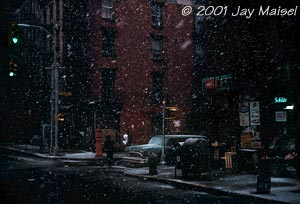
Jay: Well, there's certainly a family relationship there in
terms of the placement and the concept and the quality of the image
and the quality of the lenses and the quality of the camera. But I
would say that it seems so much more trouble free than the film
cameras I've used. I mean I'm not sending it in for repairs as
often. But then, I've noticed as the F series
increased, and I started with the original Nikon F. As it increased,
I used to have 16 Nikon F's, because there were always like four in
the shop, four coming back from the shop, four at work, and four
spares. By the time we got to the F5, I only had two bodies. I
didn't need any more. It became a lot more efficient.
Chris/Larry: How about the D1's unique abilities? It has some
variations in the way that it works - such as the 50% apparent increase
of focal length. Do you miss your really wide lenses, or do you find
that to be a helpful thing?
Jay: No. I'll tell you, remember I said I shot one roll of
film? That roll of film didn't work out by the way. That roll of film
was shot because there was a rainbow that was very unusual here because
usually rainbows go on a flat plane in relation to the city and I guess
go North and South. This one went, because of the time of day, because
of the time of year, this one went from right in front of my building,
which is due East, looking East, went all the way up to the Empire State
Building. And, I couldn't do it with my 14, because the 14 became a 21.
And so I ran and did it with another camera but it just didn't work out
because I was in full panic and screwing up.
Chris/Larry: (laugh) One of those moments that you were afraid
would disappear at any second.
Jay: And it did. And the fact that there's a 50 percent increase
works for me in my favor because I've almost never really loved wide
angles. I use them, and I can use them well, but I tend to see in terms
of telephoto. And if we're looking at a scene together, me and another
photographer, he may see what's out to the edges peripherally. I tend to
look straight in the center of what I'm looking at and that's where the
telephoto shot is.
Chris/Larry: Have you taken advantage of any of the other
remarkable features like the astonishingly high speed shutter like a
16,000th of a second?
Jay: I tried to. I tried to just because I like to see what
things look like at that, and I've used it at times, but I never really
sat down and said, OK, I'm going to stop a bullet or I'm going to stop
water, or something like that. But it's funny you mention it because
that is something I always tell people, "you've got a 16,000th on this,
you know it's terrific."
Chris/Larry: What about it's ability to work with flashes like
the SB-28dx, it communicates well with that particular flash?
Jay: Yes, I've used that on occasion, but I'll tell you, one of
the reasons I like this camera is I almost don't need flash.
Chris/Larry: Because of the higher speed?
Jay: Well, you guys are probably more technically knowledgeable
than I am. By the way, I have an associate here his name is Geoff Green,
and if you want to talk technical stuff, he would be the guy to talk to,
if I can't help you I'll put him on. I don't know what kind of shutter
inside of that. I assume it's not a normal shutter, right?
Chris/Larry: I've read that it's an electronic shutter.
Jay: Yeah, OK. So I can hold down to a 15th now. I'm an old
guy. I don't have the shakes but to hold down to a 15th hand held is
pretty wild. So, with the fact that I'm now shooting 200 ASA, and all my
life I've only shot 50 or a hundred, tops, and I never liked to push
film, I'm now, effectively my shutter speed is always higher. Plus the
fact that this sucker amplifies light. I'm sure you're aware of that.
Chris/Larry: Well, I know that it certainly has the ability to
work at different ISO's or ASA speeds.
Jay: No no, I'm not saying that. I'm saying that if you take a
photograph at the recommended ISO, in a bad light situation, you will
look at it and be amazed at how much detail it pulls out.
Chris/Larry: Opens up the shadow details. The ability of the
sensor to see into the shadows.
Jay: It's astonishing.
Chris/Larry: The digital information is there.
Jay: Yeah. I mean it's there as soon as you shoot it. You look
at it and I can close down and I can get a higher shutter speed. It's
giving me more than I can see practically. The thing that I love about
it is, anybody tells you different is full of shit, what I'm telling you
is true. After 45 years in the business, I worry about exposure and I
know everybody does. I mean, guys that have been in the business longer
than me worry about exposure. So, the joy of being able to check my
exposure is just like an incredible luxury.
Chris/Larry: So you review the images right as you shoot on the
LCD screen?
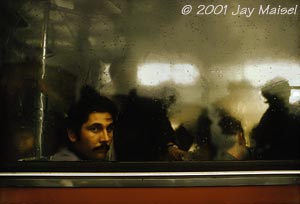
Jay: Right, because if I do a long, long shoot, I might not
look so much. But if I'm shooting intermittently and I'm moving
around the city and I'm shooting, I'm going to check it almost
always.
Chris/Larry: Do you delete the images that don't make it right
there on the spot or do you keep them?
Jay: Well I used to. But I found that that was very time
consuming and I was missing the action of it happening in front of me.
Deleting the images on a regular basis is almost like getting model
releases. It takes up too much God damned time.
Chris/Larry: What about the histogram display? Do you ever
switch to that to see if the tonality is there according to that?
Jay: No. That's what I mean. I'm not a technician and I know I
should do those things, but I don't.
Chris/Larry: How do you think in terms of exposure when you're
shooting with the D1? Do you expose for the highlights like you would
with transparency film?
Jay: I'm exposing for the highlights and the midtones,
certainly not exposing for the shadows because if you blow it out
there's nothing there to print. The other way around you can play with
it.
Chris/Larry: Speaking again of the LCD. Do you ever show your
subjects the shots you've just made of them?
Jay: Well sure.
Chris/Larry: Just as you shoot them you turn around and show it
to them?
Jay: Yes that's the joy of it.
Chris/Larry: It is. What media do you actually store your images
on when you're shooting? Do you use like a MicroDrive, or CompactFlash
card?
Jay: No, I've never used a MicroDrive. I use like a Lexar
CompactFlash card.
Chris/Larry: Do you carry spare flash cards?
Jay: God yes. A wonderful thing happened to me today. I found
two cards that had been lost for months.
Chris/Larry: Did they have good images on them?
Jay: I haven't seen whether they had any images on them. I
haven't had a chance to. I just found them twenty minutes ago. But, in
fact, if there's one thing that's a pain in the ass in this business and
working with these things, it's like finding a pack of matches.
Chris/Larry: Yeah, they are small.
Jay: I talked to a friend of mine who does use a MicroDrive, and
I said are you worried about losing any. He said, "What do you mean by
losing any. I only have one and never take it out of the camera. It
takes 800 shots. What the hell do I need a second one for?"
Chris/Larry: Right. The one gig are phenomenally large amounts
of space to work with.
Jay: But from what I've heard, and this is again from a
non-technical person. There is a chance of trauma to that thing. There's
a chance of malfunction. And I've heard of guys not being able to get
some pictures off that thing. The MicroDrive.
Chris/Larry: What about the way you shoot? Are you freer in
shooting now that you have virtually unlimited film that you carry with
you?
Jay: It's funny. At first I was tighter. And I can't explain
why except that I felt like I had to delete everything that wasn't good.
It's really in a way, it's not unlimited. There's only a finite amount
of cards that you have with you. But you usually walk around a job with
enormous amounts of film. So that's not a consideration. But now that I
don't worry too much about deleting it, I feel much freer to shoot.
Chris/Larry: What about batteries? Batteries of course are a
consumable.
Jay: And batteries tend to go a lot more if you use that viewer
the way I do. When I walk out in the street, just for myself, I usually
take a 50mm, a few flash cards, and at least one extra battery. Because
I just think the insanity of walking around with a camera that doesn't
have a battery and you're dead. You know, it's crazy.
Chris/Larry: Are there any other considerations when shooting
digitally? Do you just carry the one 50, which would actually be
equivalent to a 75? Just carry the one lens and go looking?
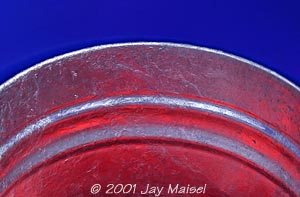
Jay: Well, my feeling has always been, the more equipment
you take, the less pictures you take.
Chris/Larry: Interesting. That's a good
philosophy. We've all experienced that, you get wrapped up in
equipment.
Jay: Somebody said to me, if you're going out for a week or so,
what would you take? At this point I'm really excited about the Nikon
80-400. Cause what you've got there in your hands is a 120-600. You are
now hand holding a 600mm lens.
Chris/Larry: With image stabilization.
Jay: Yes, with image stabilization. Not only that, but you can
put a half extender on it and you are now hand holding a 180-900mm lens.
That's very, very drastic.
Chris/Larry: At a 15th of a second.
Jay: No, hopefully not, but you may have to because the damn
thing is only an F5.6.
Chris/Larry: Speaking of the new Nikon bodies and the new
lenses. Have you experimented with any other Nikon digital cameras, like
the CoolPix 990, which is their prosumer camera, or Kodak's bodies, like
the 620?
Jay: No.
Chris/Larry: So you're using strictly Nikon's digital equipment
now?
Jay: Strictly.
Chris/Larry: How many D1's do you have?
Jay: Two.
Chris/Larry: What is the quality of compression that
you use in the camera, or do you shoot uncompressed tif?
Jay: I've only shot "Jpeg fine". And I've been very
thrilled with that, but I do want to start shooting with the other stuff
where you get less images per card, but you get much better quality.
When I've talked to people they've said you're not going to notice the
difference in the quality unless you go up to a very very big print. And
then I hear, I keep on saying I hear, because I don't know, this is very
new to me. Then I hear that if I use Genuine Fractals, the program,
you'll be able to go up quite high, even without going on a bigger
file.
Chris/Larry: I've read that you have a fully equipped studio as
well? Do you have digital backs for any of your studio equipment?
Jay: No. Don't believe everything you read. I don't really work
that much with big format. And when I do it would be film.
Chris/Larry: How do your commercial clients react to your
working digital? Do you do any commercial work at all any more?
Jay: I do some, and I've had mixed reactions. In one case I had
a client, and this is a while ago, who said that the printer was very
unhappy with the stuff. And I realize why it's because he's used to
working with CMYK and we're giving him RGB and he's going to have to get
used to that.
Chris/Larry: That's very true. In fact a lot of things are going
to be impacted by digital. Perhaps, even the definition of what is an
original image. What do you feel what an original image is now that you
don't have a chrome that's coming right out of the camera? How would you
define an original image at this point?
Jay: Anything I give them. I mean, that's the truth because
everything is exact, even if you do a duplicate of it.
Chris/Larry: Well, you used to shoot Kodachrome.
Jay: All the time.
Chris/Larry: Then you shot Fuji Velvia.
Jay: Right.
Chris/Larry: Each of those films had a unique palette.

Jay: So does the digital.
Chris/Larry: That's my question then. How does
the tonal range and sensitivity of these new CCD's effect your
ability to previsualize? Do you just intuitively know how it's
going to react now?
Jay: But I'm not previsualizing, that's the thing. I'm able to
see what I'm getting. Now, there may be times that I say, that's not the
red that's in front of me. And Kodachrome would have gotten it. But
then, sometimes I look at Kodachrome and say that's not the blue that I
want. It's too damn blue. So, again, this is personal then, over many
many years, I think if anybody tells you they're getting exactly what
they want, they either have very low standards, or they're not looking.
Because you never got exactly what you wanted. The very nature of
photography has always been to resemble something, but not to be
identical to it.
Chris/Larry: In fact, flaws like grain, halation, edge effects.
are byproducts of film and chemical reactions. And you're leaving all
that behind. But I recall some of your images actually used those kinds
of flaws for great visual effects.
Jay: You still can do halation kind of things. You can't do
grain as much. But, you certainly can do noise.
Chris/Larry: (laugh) Do you miss those old effects? Or are you
just looking forward to using new kinds of flaws creatively?
Jay: You know, years ago I worked a lot of crazy things. I used
to do push film, I used to do wrong color. I used to do cross
processing. But that was in the 50's. And, as I continued to work, I've
gotten straighter and straighter and straighter. You know, and being
more and more concerned with the integrity of the image in relation to
what's there. So I haven't wanted to fool around. Like somebody said to
me, well you know you can't double expose on these cameras. I said, so?
It's not something that I'm terribly interested in.
Chris/Larry: Well, as the history of photography has unfolded,
we've had things like pictorialism, modernism, the decisive moment.
Those have been tied to technological advances in the photographic
medium. How do you see digital tools altering the new ways photographers
are going to approach the medium?
Jay: Well, I can't speak for anybody else, but I'll tell you
how it's effected me. I've always felt that your photograph should be an
extension of your life. In a way, that they should be a journal. And I'm
not talking about commercial work. I'm talking about your personal work.
And this has enabled me to do that, so much more efficiently. I can
shoot without worrying oh God, did I bring enough film. I can go, and
this is a biggie, I can go on trips now, and not worry, oh shit I can't
get 600 rolls of film on the plane, and I can't put it in luggage
because they may zap it. So my life has become easier in terms of
traveling because I don't have to worry about the mechanical aspects of
preserving the damn stuff. But, on an esthetic level, I think that the
Epson prints that I've been doing are so fantastic. And I remember that
somebody came over to my place who knows my work and knows that I only
use dye transfers and never did Cibachromes or type C's, or things like
that. And he picked up an Epson print and said, this blows away dye
transfers. And it really does. And of course there are things that you
can't get on the film, on the digital flash card, but you can correct
that, and get it back to where you wanted it to be.
Chris/Larry: Like the missing red in Kodachrome that time?
Jay: Yes. For instance that type of thing.
Chris/Larry: You mentioned working with bringing your personal
life and your vision together. You have a daughter, Amanda, who's eight
years old right now?
Jay: Yes, seven and a half.
Chris/Larry: You've been photographing her as an ongoing project?
Jay: Absolutely.
Chris/Larry: How does you're working with a digital camera
effect your photographing Amanda?

Jay: I'll tell you, it's saved my life, because there are so
many times that I am compelled to shoot not only by the subject, but
by the light because the light is wild, it's weird, it's strange.
Because it's not normal, it attracts me, you know because of the
rarity of it. I mean there's light bouncing around some crazy way.
It's coming off a mirror, off a building, off the sun. And you try
exposing for that with film. I've done whole shoots where I've
screwed up. I've been way over, or way under. And
with this I've been able to save it. I mean I just key in on what I
want and from there I don't have to worry about it. That's been a
lifesaver.
Chris/Larry: So in general, how would you say that a digital
camera changes the way you shoot. Does it give you a different
confidence? Or, how has it effected your vision?
Jay: I don't know if it affects my vision so much as it affects
my confidence to retain the vision that I have always had. For instance
the kind of situation where the kid is in the light and it's sunset, and
the light is very very bizarre and it's like bouncing all over the place
and there's fill where there shouldn't be fill and there's backlighting
and all those kinds of things. I just can check it out. I mean, I can
see light a lot better than I can shoot it always. You know, some people
say that they know what they're going to get. Well I've been doing this
a very very long time and I know what I'm going to get, but I don't know
if I'm going to get it right. You know what I mean? So the ability to
check it, you can't overestimate how important that is.
Chris/Larry: And as we mentioned, you see that the red is not
right, you can go back in Photoshop and fix it. Do you do any of the
Photoshop work on your images?
Jay: No, I tell you that about fifteen years ago Kodak had a
center up at Camden Maine and I was asked to come there and learn
Photoshop, nobody knew what the hell Photoshop was. Why I didn't buy
Adobe stock I'm kicking myself. But, during that week, it was myself,
and people like Paul Davis who's an illustrator, and Greg Heisler and
many many people were there. And we all got wrapped up in this thing.
And my wife says, you know, I've know you now for ten years and I've
never known you to miss a meal before. And I got so hooked on it, I
wasn't going out to eat. And, there's one of the great lies of all
times, that computers save time. They don't.
Chris/Larry: They'll take as much time from your life as you
let them.

Jay: They're time suckers. So, I'm trying not to get
involved in the Photoshop. Geoff Green, who I told you about, he
works on Photoshop. And if I get on it, he'll never get back on it.
In fact, the gag is, he doesn't want me to touch the computer. I had
to get a laptop for my own so that I wouldn't screw the computer up.
Chris/Larry: You've stated that the photographers responsible
for every square millimeter of the image area.
Jay: Yup.
Chris/Larry: How does the ability of Photoshop to post process
and alter images, affect that responsibility?
Jay: I don't think it affects responsibility. It may affect
your behavior.
Chris/Larry: In what way?
Jay: Sometimes I have said to him, can we get that out? And he
looks at me and I can hear, yeah I know, but you know, but it's just
really irritating so let's get it out.
Chris/Larry: So it's still within the integrity of the image to
remove an element which is a discord element…
Jay: No no, I'm not removing elements, but I will crop. Which I
never used to do before.
Chris/Larry: Ok, so that, say actually moving an object, or
eliminating an object would be beyond where you would go.
Jay: Yeah, I don't want to go there and it's not that I think
it's unholy, but I just think it's like, let me tell you a story. A long
story if you don't mind. I used to work with Buckminster Fuller. He was
an editor of Fortune once. He went along with a photographer doing
something on the defense line. And they had to actually stop production,
which is an enormously difficult thing to get them to do during the war.
And the guy had to take a shot. And it's a long story setup, but
basically he took one frame. And then Fuller said you're not going to
take any others? And he said, no, once you start doing that you get very
sloppy. And I've never been influenced by that because I shoot a lot,
but I always feel that once you start arbitrarily saying, well lets crop
this off, let's move this over, it's not the way I want to play the
game. And I think that the essence of it is that I'm really more
interested in showing you what's great that's out there, then showing
you how terrific I am in constructing things.
Chris/Larry: I remember reading a story about how people used
to go through your trash to salvage your 35mm outtakes. That stopped you
from throwing any slides out. How has digitally shooting changed that?
Obviously you don't have the slides to worry about. Once you bring those
images home that don't quiet make it, do they just get deleted?
Jay: Well, that's a big problem because when I'm out shooting I
don't want to spend my time deleting it, well, when I'm back home I
don't want to spend my time deleting it either. So we just put it on
disks and I just pick the one's I want and the rest of them just stay
there.
Chris/Larry: So you just archive them?
Jay: Yeah. I mean at first I though, oh God, we were going to
pile up this crap, I realized that it's not that difficult, I can buy
more memory. It's not a big problem. We make double CD's. We back it up.
Eventually it comes off the hard drive. So it's not like you have to buy
a new hard drive every time.
Chris/Larry: CD's only cost forty cents now.
Jay: CD's are cheap and they don't take up that much space. And
there is a certain laxity mentally about doing this, but I keep on
thinking, the advice that I sometimes give to students is that, be aware
what you're shooting, and try and have perspective on it, because what
you're shooting today might not seem important, but twenty years from
now it may be a very very valuable record of something.
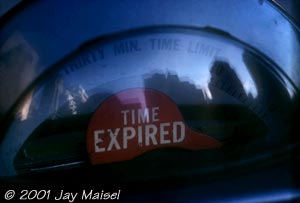
Chris/Larry: And toward that end, too, one of the fears that
people had with digital is that the prints would not be around in
the future because of the instability of dies. That fear is
subsiding now with the new kinds of printers.
Jay: You mean the Epson. My big thing is I want to get the
archival ink Epson's. I want to get one of the big ones. And be able to
sell prints that I know will be as good as my dye transfers, or better.
Chris/Larry: That's the 7500?
Jay: The 9500.
Chris/Larry: Along those lines, I've read that you've also used
the 1270 to print some of your images.
Jay: Oh yeah, that's all we're using so far.
Chris/Larry: That's what you use in house is a 1270?
Jay: Yeah, they're incredible images. I mean, I can't believe
some of them. In fact, there was one that was so good I said let's
review the camera data for that image. That's another thing that's very
good is that you can get the data back. And, we looked at the data, and
the amazing thing was it wasn't even shot at 200, it was shot at 400.
Chris/Larry: Ah, because that was encoded right with the image.
Jay: What's encoded with the image, is a pedigree of everything
you might want to know about the image. It tells you number one, what
exposure compensation you used. Because I'm always using exposure
compensation because I want it darker or lighter. It'll tell you what
f-stop you used. It'll tell you what shutter speed you used. It'll tell
you what lens you used. If you used an 80-200, it will tell you that it
was at 137mm. So all this bullshit that you see in photo magazines about
the picture that you took twenty years ago, and you and I know nobody
knows what the hell they took and they give you data on it. But now you
can have actual data.
Chris/Larry: Do you think that the old wet darkrooms are going
to be bypassed? Do you think that people are going to go over entirely
to digital output devices?
Jay: I'd be very surprised if they don't. Especially in color.
I mean for people printing in black and white, that's another story
because they're doing it and there's a certain joy in making prints.
There's really not a lot of joy in making a color print, it's a very
different kind of process then making a black and white print,
especially if you're working in negative stuff. Now if you had a choice
whether you could work in a media where you didn't have to have a
darkroom or you did have to have a darkroom, what would you pick?
Chris/Larry: Well, I'm seriously thinking about selling my own
darkroom, (laugh) and have been because I know the feeling of going into
a color darkroom.
Jay: Now the only reason I have not dumped my darkroom
altogether, because I have not really worked in a darkroom myself for
about 35 years. And I used to love to work in darkrooms but I think
that's a stage in your career and then you get over it, because for me,
the thing happens at the moment of exposure. What happens afterwards is
relatively straightforward if you know what you're doing and you just
want to capture the moment that you hope you had captured at the
exposure. But the only reason I stayed with the darkroom is, one of my
long-term projects is, I want to get back to doing something I did years
ago. I used to do a lot of photograms. And those may need to be done in
a darkroom. Otherwise I think I would dump the darkroom.
Chris/Larry: Many years ago, in fact, you worked under the
painter Joseph Hirsch, you studied painting at Cooper Union. You
received a degree in painting in fact from Yale where you studied with
Joseph Albers. Have you ever wanted to sit down with a digital stylus
and paint digitally using any of the natural media painting programs or
Photoshop itself?
Jay: That's what I was doing up in Camden. I wasn't even
touching photographs. I was just playing with the ability of the
computer to do things in color. In fact the guys who had worked on
Photoshop, "to give you an idea about how technical I am", the guys who
had worked on the program were going around watching what we were doing
and they came to me and they said, how'd you do that? I said, I had no
idea. Well, could you do it again? About the same chance of, you know,
sixty monkeys writing the Encyclopedia Britannica. Sooner or later I'll
get it again. I said why do you ask? He said I've never seen that
before. And so, my structure and working is a hell of a lot less logical
and more intuitive than computers demand. But the thing I liked about
computers is that it gives you the chance, when you come to the fork in
the road, you can take both forks.
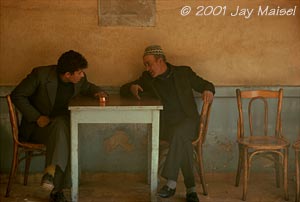
Chris/Larry: Right, you can always go back again.
Jay: Right, that's the beauty of it.
Chris/Larry: Have you experimented with any
painterly affects that could alter your photographic images in
color and form?
Jay: Nope, I don't want to do that at all. I really want to be
stimulated by what's out there. I don't want to do tableaus of things
that I have in my head. I mean if I have a job to shoot and someone
wants me to light it in a very special way that's one thing. But what
I'm really interested in are the fantastic things that happen out there
you're not really aware of.
Chris/Larry: How about something like stitching together various
digital images into a panoramic format. Have you ever done that where
you decided to carry a greater space than fits in the frame and shot
several frames side by side and then stitched them digitally?
Jay: In 1974 I started shooting panoramic cameras. And I loved
shooting panoramic cameras. That is one of the things I think I'll be
going back to film on, shooting panoramic. I have not tried to stitch
anything together because whenever I wanted to do it I could do it in
one shot. But, I could do something now that I couldn't do before. I
have an image that's 40 inches high and 180 inches long. That's fifteen
feet by three and a half feet. And it's three dye transfers that are
keyed together. And the reason it's in three pieces is that they can't
make a dye transfer that big. But now, I can make that thing in one
piece of paper, which is fantastic.
Chris/Larry: So, with all these changes coming at us. What do
you see as the future of photography, both commercially, and as a
continuing evolving and developing art form?
Jay: Well I think technically, film ain't gonna die. I mean
there are too many people who really enjoy the quality of film and the
wide-angle thing. But I just can't believe that people aren't going to
switch over to digital on a professional level. It's too rewarding not
to. I won't get on Photoshop. I won't get on a computer. But there are a
lot of people who really love doing that kind of thing and it gives them
a chance to have their own darkroom, on a desktop, and get quality that
is superior to what they can get from anybody else. In an hour or to, or
in a few minutes, if they're really good at it. And they don't have to
go out of the house. Everything is in their house. And I think as the
printers get used to the RGB and the CMYK won't be a problem in that and
as, do you know Nikon's new camera? Do you know anything about that?
Chris/Larry: I've read about it on their web site.
Jay: So that, the existing one and a half megabytes that you
get, compressed, that opens up to seven and a half, is going to be
replaced by eighteen megabytes. It's going to be incredible.
Chris/Larry: I think it's a 5.47 megapixel camera so it's quite
a jump up from what you've been using.
Jay: Oh yeah. And Epson, who has been making the 1270 that is
really quite incredible, and I think the quality is so superb. I can't
get over the combination. It's great. They're changing from the 1270,
which is 1440 dpi, the 1280, which is going to be 2880 dpi. So I've got
a camera that is going to be twice as good in terms of quality. And a
printer that going to be twice as good in terms of quality. I don't know
if I can stand this. (laugh)
Chris/Larry: Have you seen a movement among your peers to adopt
digital cameras?
Jay: Oh yeah. Not all of them, but you know, some of them. I
think the factor that scares a lot of them is the adaptation of it by
their clients, you know. And here's why I think the digital thing is
going to happen, and even though there's a lot of photographers don't
want it to happen. I've had photographers say to me, well you know,
they're going to be looking over your shoulder as you shoot. And I say,
great. Then they won't say to you, "that's not what I had in mind" when
they see the film. It becomes more of a contemporaneous relationship
instead of an adversarial relationship.
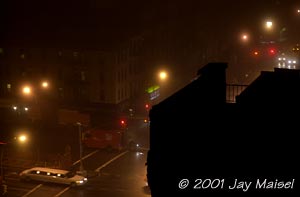
Chris/Larry: The ultimate in Polaroids.
Jay: Oh yeah, that's the beauty. No more money on Polaroids.
Chris/Larry: And you'll be able to complete a job, at that
time.
Jay: Well I did this one big job, the client and I had worked on
the thing together and it was a very complicated thing with many many
people in it, and all kinds of strange lighting. And he was able to say
that's it, you don't have to work anymore on that, let's move onto the
next one. We normally would just overshoot like crazy to make sure we
had it. But we were able to get what we wanted, know that we had it, and
move on. And if it wasn't right, we could just correct it right there
instead of thinking when the whole thing was finished, "Oh God, do you
know what we should have done?"
Chris/Larry: Right, so you have the ability to get the client to
sign off and understand what he's going to get before the shoot is even
over.
Jay: Right.
Chris/Larry: What kind of advice would you give to
photographers that are just starting out now? What should they study in
school? How should they approach the medium now that digital is becoming
so strong?
Jay: Well, my feelings always been, when you're talking about
studying, that studying photography is kind of dopey. You know. You
should study the basic arts. I'm talking about my own experience,
obviously. But you should study as much visual art as you can. The
photography should come secondary because the other thing is the basis
for it. I mean, if you don't know what you're doing visually, it doesn't
matter what you know about a camera. And, basically cameras ain't brain
surgery. They're easy to pick up. They're easy to learn about. I'm not a
good technician. I still can take pictures. But what I think is
important for them is to have an awareness of visual, I'm trying to
think of a word for it, of a visual protocol. To know what works
visually whether it's in a camera, a painting, a piece of sculpture,
landscape, architecture, pottery, or anything.
Chris/Larry: So, the visual protocol. Is that something that is
more aligned with one's own inner vision and sensibility, rather than
something that can be taught?
Jay: That's an interesting question. One would hope that if
you're taught to bring out your inner vision. But I think it has to do
with your influences I mean. What were your influences as you were
studying and learning. Were your influences, you know, Norman Rockwell?
Which ain't bad, but, or was it Monet? Or was it Mondrian? You know.
What was it? Were you looking at great vases? Do you have an idea what
Persian carpets are like? I'm quoting myself, so forgive me if it sounds
pedantic. But, our history of photography didn't start with the
daguerreotype. It started with cave painting. And since the cave
paintings, art has not moved forward, it's just changed. It has not
gotten better, it's just gotten different.
Chris/Larry: What about the Internet and the ability for
photographers to show their work around the world? Do you see that as
having an effect on the way in which artists and photographers will be
able to market and to exhibit their work?

Jay: I think that it certainly has a chance but the thing
that has always scared all of us is loosing the stuff to somebody
who is less than scrupulous about it.
Chris/Larry: Right. Digital images are very easy
to copy.
Jay: Oh boy.
Chris/Larry: And there are few really convenient and effective
means of copy protection. It seems like convenience and effectiveness
are at opposite ends of the spectrum at this point. But do you see that
there is an ability for an artist to communicate with the audience that
they have in a new way because of the Internet?
Jay: Well I just think that there are a lot of openings there. I
mean you can start getting into stop action stuff if you want. You can
create your own videos if you want. I mean there's so many things you
can do. As a still photographer it just gives you a different kind of
venue. It gives you a chance to put something up without making a big
investment. I mean, it becomes a semi publishing adventure.
Chris/Larry: When you began, you just hit the streets and you
walked around and you showed art directors what you did. Many years ago
there was greater accessibility of just showing your portfolio.
Jay: Oh God yes.
Chris/Larry: Do you think that you have any advice for people
who need to reach that same audience? Is the Web an effective way to do
that?
Jay: Well, I don't think you can walk around anymore. That's
the problem. I think if you try to walk into somebody's office, the best
thing you're going to have is a drop off. It's hard to meet people on
that basis because everybody's so busy and they don't have time to see
another damn photographer, and they don't really want to see anybody,
you know. If something's on the perspective of their vision catches
their eye, they'll go for it. And the perspective of their vision is
usually what's in magazines already or maybe something they see on the
Internet. But they don't want to go through portfolios. You know, it's a
drag for them, I mean. Even years ago I used to have to kick and bite
and scream to get them to sit down and look at a carousel reel.
Chris/Larry: So, now it's even more difficult?
Jay: On a personal level, yes. I think the Internet might very
well be a good way to do it. I mean, you can put your whole portfolio on
a CD and send it to a guy, you can't make them look though. That's still
the difficulty.
Chris/Larry: Well your web site has images and access to your
imagery. Have you found your web site a successful means of showing and
selling your work?
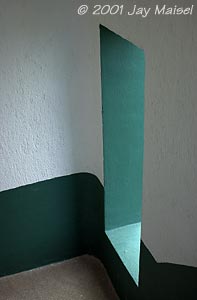
Jay: I think my web site stinks. And I haven't really
worked on it enough. I mean, there are people who like it and for
that I'm very grateful. But I don't think it's full and
comprehensive as it should be and it's my fault, it's nobody else's.
We haven't gotten a lot of work off of it. We've gotten inquires and
we've gotten compliments and things, but I haven't found it a
vehicle for generating a lot of income.
Chris/Larry: Do you have any plans in the near
term to update it?
Jay: Oh certainly. I also have plans to get my house in order.
(laugh)
Jay: You know I don't know if I made it clear but one of the
things that I wanted to say, I guess I did, but, I'm able to shoot more
easily now in tricky situations. And I'm able to walk around and shoot
at night. And I haven't shot at night in forty years. And now I can
shoot at night. I'll give you an example, a couple of months ago there
was a big storm, and the sky was kind of glowing because of the snow
from the city. I could hand hold it and shoot it. Cause I know I
wouldn't go and get a tripod. I'm too fuckin' lazy. And we made a print
of that for the show down in PMA.

Chris/Larry: One of the images that influenced me the most,
and I guess it was about thirty years ago, was a picture of a
silhouette of a window washer washing the window at an airport, a
New York airport.
Jay: No, Bogota Columbia airport.
Chris/Larry: With a backlight, with a nice sun behind it.
Jay: Yes.
Chris/Larry: How would you have approached that same shot
today digitally?
Jay: The same way. No difference what so ever. I mean the
digital stuff helps you to shoot in situations that are tougher but your
visual handle that you have on it remains the same. The only thing that
changes is that the subject might becomes more accessible to you.
Chris/Larry: I was just thinking. The next picture we need to
see of you is one of you lying on the floor of your studio covered with
CompactFlash cards.
Jay: (laugh) I can't afford that!

